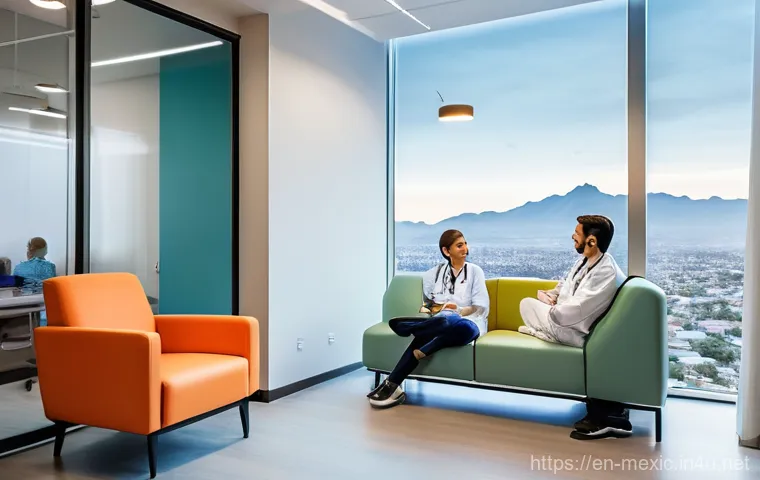Stepping into the vibrant culture of Mexico, whether for a dream retirement, an adventurous digital nomad stint, or just an extended escape, often brings up a crucial question: “What about healthcare?” Trust me, it’s a thought that crosses everyone’s mind, and from my own experiences living and traveling across this incredible country, I’ve gained a pretty solid understanding of its medical landscape.
Forget what you might *think* you know; the reality here is often a pleasant surprise, blending world-class facilities with an affordability that can feel like a breath of fresh air compared to many other nations.
Many are now flocking here specifically for medical tourism, discovering that top-notch care doesn’t have to break the bank. But how does it all really work, from the public system to private hospitals, and what’s the secret to navigating it smoothly as an expat or visitor?
It can seem a bit overwhelming at first glance, but I’m here to demystify it all for you. Let’s peel back the layers and discover the exact realities of Mexico’s healthcare system together.
The Dual Path: Public vs. Private Healthcare Decoded

This is often the first thing people grapple with when they arrive – trying to figure out if they should go public or private. It’s a completely different ballgame than what many of us are used to, especially if you’re coming from a system with a single, overarching healthcare provider. From my perspective, having dipped my toes in both waters, the key is understanding that Mexico truly offers a bifurcated system, each with its own quirks and benefits. It’s not about one being inherently ‘better’ than the other; it’s about what fits your needs, your budget, and your comfort level. I remember feeling a bit lost at first, trying to untangle the acronyms and understand the eligibility requirements. But once you get a handle on it, you realize the flexibility is actually quite empowering. You’re not stuck with one option; you have choices, and that’s a huge advantage. This dual system is a testament to Mexico’s commitment to providing care, albeit through different avenues that cater to various economic and social strata.
Unpacking the Public
The Instituto Mexicano del Seguro Social, or IMSS, is the cornerstone of Mexico’s public healthcare. Think of it as the national social security health program, primarily for employed individuals and their families. If you’re working legally in Mexico, your employer contributes to IMSS, and you’re covered. It’s comprehensive, covering everything from general consultations and specialist referrals to surgeries, hospital stays, and even some medications. I’ve heard stories from friends who’ve had serious procedures done through IMSS, and while the wait times can sometimes be a test of patience, especially for non-critical specialist appointments, the quality of care in many larger cities is surprisingly good, often delivered by highly competent doctors. The challenge, especially for expats not formally employed, used to be accessing it easily. Now, with recent changes and the move towards more universal care with schemes like IMSS-Bienestar, access for residents is becoming more streamlined. It’s not always shiny and new, but it gets the job done for essential care.
The Allure of Private Healthcare: Comfort and Immediate Access
On the other hand, private healthcare in Mexico is where many expats gravitate, and for good reason. It’s akin to what you might find in the US or Canada in terms of facilities and service. These hospitals are typically modern, well-equipped, and boast English-speaking staff and doctors, which can be a huge relief when you’re not feeling your best. My first experience with a private clinic here was for a minor injury, and I was genuinely impressed by the efficiency and personalized attention. You walk in, register, see a doctor, get your prescription, and often leave within an hour or two. The costs are significantly lower than private care in North America, making it an incredibly attractive option even for those without comprehensive insurance. It’s often a pay-as-you-go system, or you can use international health insurance. The peace of mind that comes with knowing you can get immediate, high-quality care without the bureaucracy can be priceless.
Understanding Public Healthcare: Navigating IMSS and Beyond
Okay, so let’s really talk about the public system. For many, especially those planning a long-term stay or retirement, figuring out IMSS (Instituto Mexicano del Seguro Social) is essential. It’s Mexico’s national public health insurance system, and it’s meant for formally employed individuals. But here’s the thing: it’s actually accessible to many expats and residents now, even if you’re not working for a Mexican company. They have a voluntary enrollment program, and while it might seem a bit complicated to sign up, I’ve seen countless people navigate it successfully. The cost is surprisingly affordable, often just a few hundred dollars a year, depending on your age. For that, you get comprehensive coverage: doctor visits, specialists, hospital stays, surgeries, medications—the works! It’s truly incredible value, especially if you’re coming from a country where healthcare costs are astronomical. The main trade-off, as I mentioned, can be wait times for non-emergency services and sometimes older facilities compared to the swanky private hospitals. But for routine care and essential treatments, it’s a lifesaver, offering a robust safety net.
The Evolution: From Seguro Popular to IMSS-Bienestar
You might hear older expats talk about “Seguro Popular,” which was Mexico’s previous public health program for those not covered by IMSS. Well, that’s largely been phased out and replaced by a new system, primarily IMSS-Bienestar. This is a significant shift, aiming for more universal healthcare access, particularly for those without social security. It’s designed to provide free medical care, medications, and hospital services to the uninsured population. My friends living in smaller towns have found this incredibly beneficial, as it means basic healthcare is more readily available without the need for enrollment fees. It’s still a work in progress, and its reach and effectiveness can vary by state and region, but the intent is clearly to ensure that everyone, regardless of employment status, has access to basic medical services. It’s a testament to Mexico’s ongoing efforts to improve healthcare equity, and I personally think it’s a huge step in the right direction towards social welfare.
Eligibility and Enrollment for Expats
So, how do you get into IMSS? If you have your residency (temporary or permanent), you can often apply for voluntary enrollment. It usually involves going to an IMSS office, filling out some paperwork, and undergoing a basic medical exam. They’ll assess any pre-existing conditions, which can sometimes impact your eligibility or initial coverage for those specific conditions, but it’s generally quite straightforward for most. The monthly or annual fees are based on your age, making it transparent. I remember helping a friend through the process, and while it took a few visits, the staff were generally helpful, even with my broken Spanish. It’s a small investment for substantial peace of mind, especially if you plan on making Mexico your long-term home. Don’t let the bureaucracy deter you; it’s totally worth the effort for the extensive coverage it provides, covering everything from minor consultations to major surgeries.
Embracing Private Care: A World of Comfort and Choice
When I first moved to Mexico, I gravitated almost immediately towards the private healthcare system, primarily because it felt familiar. The quality of private hospitals, especially in major cities like Mexico City, Guadalajara, Monterrey, or even smaller expat hubs like San Miguel de Allende and Puerto Vallarta, is genuinely world-class. We’re talking about modern facilities, state-of-the-art equipment, highly trained specialists, and often, the convenience of English-speaking staff. It’s a stark contrast to some of the public facilities, not in terms of medical expertise necessarily, but definitely in amenities and efficiency. I’ve personally visited several private hospitals for various reasons – from routine check-ups to assisting a friend with an unexpected appendectomy – and each time, the experience has been incredibly smooth and professional. The peace of mind that comes with knowing you can get immediate attention, often with minimal wait times, is a huge draw for many expats. It truly feels like a premium service, without the premium price tag you’d expect back home.
The Advantages: Speed, Comfort, and Personalized Service
The biggest perk of private healthcare, in my humble opinion, is the speed and comfort. You typically don’t need an appointment for a general doctor’s visit – you just walk in, register, and often see a doctor within minutes. For specialists, appointments are usually easy to get within a few days, not weeks or months. The rooms in private hospitals are often private or semi-private, clean, and comfortable, feeling more like a hotel than a medical institution. The doctors often spend more time with you, explaining things thoroughly, and truly listening to your concerns. I remember a time when I had a rather perplexing skin rash, and the dermatologist in a private clinic went above and beyond, running tests and providing detailed explanations, something I rarely experienced with hurried appointments elsewhere. This personalized approach makes a huge difference, especially when you’re navigating a foreign healthcare system and want to feel truly cared for.
Understanding the Costs: Affordability Beyond Borders
Now, let’s talk about the money side. This is where Mexico’s private healthcare really shines. While it’s ‘private,’ the costs are a fraction of what you’d pay in the United States, and often significantly less than in Canada or Western Europe, too. A general consultation with a private doctor might cost you anywhere from 500 to 1,200 pesos (roughly $25-$70 USD). Specialist visits are a bit more, perhaps 800 to 2,000 pesos ($45-$115 USD). Even major surgeries can be surprisingly affordable compared to international benchmarks. This affordability is a key reason why medical tourism to Mexico has boomed. People fly in for dental work, cosmetic surgery, and even complex medical procedures because the quality is high and the price is right. I’ve often paid out-of-pocket for minor issues because it was simply more convenient and often cheaper than going through my travel insurance deductible. It’s a fantastic option for quality care that doesn’t completely drain your wallet.
| Feature | Public Healthcare (IMSS / IMSS-Bienestar) | Private Healthcare (Out-of-Pocket / Private Insurance) |
|---|---|---|
| Cost | Very low to free for residents; nominal annual fees for voluntary IMSS enrollment. | Significantly more affordable than US/Canada; pay-as-you-go, or covered by private insurance. |
| Facilities | Varying quality; can be older, especially in smaller towns. Major city hospitals are often well-equipped. | Modern, state-of-the-art hospitals and clinics, comparable to international standards. |
| Wait Times | Can be long for non-emergency specialist appointments and elective procedures. | Minimal to no wait times for general consultations; specialists usually available within days. |
| Staff | Highly competent doctors and nurses, but English-speaking staff may be limited. | Often English-speaking doctors and support staff, especially in expat-heavy areas. |
| Coverage | Comprehensive for enrolled members (doctor visits, specialists, surgery, medications). | Wide range of services available; covered by insurance or paid directly. |
| Access | Requires residency and enrollment (for IMSS) or available to uninsured (IMSS-Bienestar). | Open to everyone, regardless of residency or insurance, upon payment. |
Health Insurance: Your Shield in Mexico
Alright, so you’ve got a handle on the public and private systems. But what about insurance? This is a question I get all the time, and it’s a really important one. While Mexico’s healthcare is more affordable, unexpected medical emergencies can still hit your wallet hard, especially if you’re looking at serious surgeries or extended hospital stays in a private facility. I personally wouldn’t dream of living here without some form of health coverage. It’s like having a safety net; you hope you never need it, but you’re profoundly grateful when it’s there. The good news is, you have options, from international plans that cover you worldwide to local Mexican insurance providers. The choice really depends on your lifestyle, your health needs, and your budget, but securing some form of insurance is, in my professional opinion, non-negotiable for peace of mind.
International Health Insurance: Global Coverage and Flexibility
Many expats opt for international health insurance plans. These plans are fantastic because they typically offer global coverage, meaning you’re covered not just in Mexico but also when you travel back home or to other countries. They often come with higher premiums than local plans, but they also offer a broader network of hospitals and doctors, higher coverage limits, and often direct billing, so you don’t have to pay out-of-pocket first. I know several people who swear by their international plans because it gives them the flexibility to choose where they receive care, and in an emergency, that’s incredibly valuable. You’ll find major providers like Cigna, Bupa, and IMG offering plans tailored for expats. Just be sure to read the fine print about deductibles, co-pays, and pre-existing conditions. It’s an investment, but one that truly pays off when you need it most, providing a comprehensive safety net no matter where you are.
Local Mexican Insurance: A More Affordable Alternative
If you’re planning to spend most of your time in Mexico and want a more budget-friendly option, local Mexican health insurance could be a great fit. Companies like GNP, AXA, and Atlas offer comprehensive plans that cover private hospitals and doctors within Mexico. The premiums are generally lower than international plans, and they’re designed specifically for the local healthcare landscape. The main difference is that their coverage is typically limited to Mexico, so if you travel frequently outside the country, you might need supplemental travel insurance. However, for everyday care and even major medical events within Mexico, these plans provide excellent coverage. I’ve seen friends successfully claim for everything from broken bones to serious illnesses with their local plans, and while the administrative process can sometimes involve a bit of paperwork, it’s manageable and provides excellent value for money, making it a very practical choice.
Beyond the Basics: Specialized Care and Medical Tourism
Mexico isn’t just about general practitioner visits; it’s a significant hub for specialized medical care and has really made a name for itself in the realm of medical tourism. This is something I’ve seen firsthand, with friends and acquaintances traveling from the US and Canada specifically for procedures ranging from complex dental work and cosmetic surgeries to bariatric surgery and even orthopedic operations. The draw is undeniable: world-class medical professionals, cutting-edge technology, and costs that are often 50-70% less than what you’d pay back home. It’s not just about affordability, though; the quality of care and the personalized attention you receive in many of these specialized clinics are truly exceptional. It’s an eye-opener for many who assume ‘affordable’ means ‘compromised quality,’ proving that you truly can get top-tier service without the exorbitant price tag.
Dental and Cosmetic Procedures: A Popular Choice
When people talk about medical tourism in Mexico, dental work often comes up first. I’ve heard countless success stories about people getting high-quality implants, crowns, and extensive dental care for a fraction of the cost they would pay north of the border. Dentists here are often incredibly skilled, with many having trained internationally. Similarly, cosmetic surgery is another huge draw. From rhinoplasties to facelifts and body contouring, Mexico has a plethora of highly reputable plastic surgeons. The clinics are usually pristine, recovery facilities are excellent, and the overall experience is often praised by those who’ve gone through it. It’s an opportunity to receive treatments that might be financially out of reach elsewhere, without sacrificing quality or safety. Just remember to do your research, read reviews, and choose board-certified professionals, just as you would anywhere else, to ensure the best possible outcome.
Advanced Medical Treatments and Wellness Retreats

Beyond dentistry and cosmetics, Mexico is also gaining traction for more advanced medical treatments. This includes things like bariatric surgery for weight loss, fertility treatments, and even certain types of cancer treatments. Many hospitals in major cities have specialized departments with leading experts in their fields. What’s more, the country offers a growing number of wellness retreats and integrative medicine centers, blending traditional and modern approaches to health. I personally found a fantastic chiropractor and acupuncturist in my town who’ve helped me immensely, and they offer services that are incredibly affordable compared to similar practices in other countries. It’s a holistic approach to health that many find appealing, combining high-quality medical intervention with a focus on overall well-being and recovery in often beautiful, serene settings, making it a compelling destination for a wide range of health needs.
Navigating Everyday Ailments: Pharmacies and First Consultations
Let’s get down to the practicalities of day-to-day healthcare. What happens when you just have a common cold, an upset stomach, or need a quick prescription refill? This is where Mexico’s system truly shines with its accessibility and convenience. You don’t always need to jump through hoops to see a doctor. In many ways, it feels incredibly user-friendly for minor issues, something I’ve come to deeply appreciate after years of navigating more cumbersome systems. It’s often a much faster and simpler process than what you might be accustomed to, and it really empowers you to take care of those minor health bumps without feeling overwhelmed, fostering a sense of self-reliance and ease that’s truly refreshing.
Farmacias and Consultorios: Your First Stop
One of the most remarkable aspects of Mexican healthcare is the “consultorio” attached to many pharmacies, particularly large chains like Farmacias Similares or Farmacias Guadalajara. For a nominal fee, often just 50-100 pesos (about $3-$6 USD), you can have a direct consultation with a doctor right there. They can diagnose common ailments, write prescriptions, and give you basic advice. I’ve used these countless times for things like ear infections, mild fevers, or just to get a quick check-up when I felt under the weather. It’s incredibly convenient and incredibly affordable. You literally walk in, wait a few minutes, see a doctor, and then step right over to the pharmacy counter to fill your prescription. It’s a system that truly prioritizes immediate, accessible care for minor issues, cutting out so many steps and saving you so much time, making it an incredibly efficient solution for common health concerns.
Getting Medications: Over-the-Counter and Prescriptions
The pharmacy system here is also quite different and often much more accessible. Many medications that require a prescription in other countries, like certain antibiotics, birth control, or even some pain medications, can be purchased over-the-counter in Mexico. This isn’t universally true for all drugs, and stronger narcotics still require a doctor’s prescription (and rightfully so!), but for many common needs, the process is incredibly streamlined. Just walk into a pharmacy, ask for what you need, and often you’ll get it. Always check the expiration dates and make sure you’re getting exactly what you asked for. Prices for medications are generally very reasonable, especially for generics. I’ve stocked up on basic essentials like allergy meds and pain relievers here because the quality is good and the prices are unbeatable. It’s definitely a point of difference that takes some getting used to, but it’s immensely practical and a huge convenience.
Emergency! What to Do When Seconds Count
While we all hope to avoid them, emergencies can happen anywhere, and knowing what to do in Mexico can save precious time and reduce a lot of stress. It’s a situation where having a plan, even a loose one, can make all the difference. From my experience, dealing with an emergency in a foreign country can be incredibly disorienting, and understanding the local protocols can significantly ease the process. The immediate response might feel a little different than what you’re used to, but rest assured, Mexico has dedicated emergency services ready to assist when things go wrong. Don’t panic; be prepared. Having a clear head and some basic knowledge can truly be life-saving when unexpected situations arise, ensuring you get the care you need swiftly and efficiently.
Calling for Help: 911 and Beyond
Just like in the US and Canada, Mexico has adopted 911 as its national emergency number. You can call this number for police, fire, or medical emergencies. When you call, be prepared to give your location as clearly as possible and describe the nature of the emergency. While some operators may speak English, it’s always a good idea to have a few key phrases in Spanish ready, or have a Spanish-speaking friend nearby if possible. For serious medical emergencies, an ambulance will be dispatched. It’s worth noting that ambulance services can vary in quality and speed, especially in more rural areas. If you’re in a private hospital network, they often have their own ambulance services which can be more reliable and quicker to respond. Knowing your address and nearest major cross streets is crucial for dispatchers to find you quickly and effectively, ensuring prompt assistance.
Navigating Hospital Emergency Rooms
Once you arrive at a hospital, whether public or private, the emergency room experience can vary. In public hospitals, you’ll typically be triaged based on the severity of your condition, and wait times can be extensive for non-life-threatening issues. In private hospitals, the process is often much faster and more streamlined. If you have private insurance, make sure to inform the hospital staff immediately, as they will need to verify your coverage. If you don’t have insurance, be prepared to pay a deposit or make arrangements for payment, as private facilities often require this upfront. I’ve accompanied friends to both, and while the public ERs can be chaotic, the care for genuine emergencies is competent. The private ERs offer a much more comfortable and efficient experience, though at a cost. The key is to communicate clearly and advocate for yourself or your loved one, ensuring you receive the appropriate care in a timely manner.
My Personal Takeaways: Tips for a Seamless Healthcare Journey
After years of living and traveling across Mexico, I’ve picked up a few invaluable tips that I believe can truly make your healthcare experience here not just manageable, but genuinely smooth and stress-free. It’s all about preparation, a little bit of common sense, and being open to the local way of doing things. These aren’t just abstract ideas; they’re practices I’ve personally adopted and shared with countless friends, and they’ve consistently proven to be incredibly helpful. Don’t be afraid to embrace the learning curve; it leads to a much more comfortable and secure life here, allowing you to fully enjoy everything this incredible country has to offer without unnecessary health worries looming over your head.
Language is Your Friend: Basic Medical Spanish
Even if you’re in an expat-heavy area where English is widely spoken, learning some basic medical Spanish phrases can be an absolute game-changer. It helps with explaining symptoms, understanding diagnoses, and just building a better rapport with your healthcare providers. Things like “Me duele aquí” (It hurts here), “Tengo fiebre” (I have a fever), “Soy alérgico a…” (I’m allergic to…), or “Necesito un médico” (I need a doctor) can be incredibly useful. I’ve found that even attempting to speak Spanish shows respect and often results in more patient and thorough explanations from medical staff. There are plenty of free apps and online resources to help you learn these phrases, and trust me, a little goes a long way in making you feel more confident and understood in medical settings, truly enhancing your entire healthcare journey.
Keep Your Records Accessible: Digital and Physical
This is a big one. Always keep a digital copy of your important medical records, including any pre-existing conditions, current medications, allergies, and recent test results. A physical copy in a waterproof folder isn’t a bad idea either. I personally use a cloud service to store mine, and I have a condensed version printed out in my wallet. This is especially crucial in an emergency or if you’re seeing a new doctor who doesn’t have your history. Having quick access to this information can prevent misdiagnoses, ensure proper medication, and save valuable time. It also helps immensely if you have an insurance card or policy details readily available. The more organized you are with your health information, the smoother your interactions with the Mexican healthcare system will be, allowing doctors to provide the best care possible without delay, and giving you immense peace of mind.
Wrapping Things Up
Phew! That was a deep dive, wasn’t it? Navigating healthcare in a new country can feel like solving a complex puzzle, but honestly, Mexico makes it incredibly approachable once you understand the pieces. Whether you lean towards the affordability and community aspect of the public system or the comfort and speed of private care, you truly have excellent options here. My biggest takeaway, after all these years, is that being informed and prepared is your superpower. Don’t let the unknown scare you away from all the amazing health resources available. It’s truly empowering to know you’re covered, whatever your health needs may be.
Handy Tips You’ll Want to Bookmark
1. Always have a trusted friend or a translation app handy for any medical appointments, especially if your Spanish isn’t fluent. Even a little communication goes a long way!
2. Keep a physical and digital copy of your medical history, including allergies and current medications, easily accessible. This is a game-changer in emergencies!
3. Don’t underestimate the convenience of farmacia consultorios for minor ailments. They’re a fantastic, affordable first stop for quick consultations and prescriptions.
4. Research and secure health insurance that fits your lifestyle. Whether international or local, a safety net for major incidents is absolutely essential for peace of mind.
5. Embrace the preventative care culture! Many doctors here are keen on regular check-ups, and the costs are often so reasonable that it makes proactive health management incredibly easy.
Key Takeaways
Mexico offers a robust dual healthcare system: the publicly funded IMSS/IMSS-Bienestar provides comprehensive and incredibly affordable care, especially for residents, while the private sector boasts modern facilities, immediate access, and often English-speaking staff at a fraction of North American costs. The choice between public and private largely depends on your specific needs, budget, and comfort with wait times. Securing appropriate health insurance, whether international or local, is paramount for unexpected emergencies and major treatments, providing a crucial financial buffer. Remember, preparedness, basic language skills, and having your medical records accessible will make your healthcare journey in Mexico remarkably smooth and stress-free.
Frequently Asked Questions (FAQ) 📖
Q: Is Mexican healthcare genuinely affordable, and can I really expect good quality care, or is it too good to be true?
A: Oh, this is the million-dollar question, isn’t it? And trust me, having lived and traveled extensively here, I can tell you firsthand: the affordability is absolutely real, and the quality often exceeds expectations.
Forget those old stereotypes! Many people, myself included, have been pleasantly surprised to find that dental work, specialist consultations, and even major procedures can cost a fraction of what they would in the U.S.
or Canada. We’re talking about a significant difference that truly makes top-tier care accessible. Now, regarding quality, this is where it gets really interesting.
Mexico boasts world-class hospitals, especially in larger cities like Mexico City, Guadalajara, and Monterrey, and even in popular expat havens like San Miguel de Allende and Puerto Vallarta.
These facilities often feature state-of-the-art equipment, highly trained doctors – many of whom have studied abroad in the U.S. or Europe and are bilingual – and a patient-centric approach that can feel incredibly refreshing.
I’ve personally experienced everything from routine check-ups to more specialized treatments, and each time, I’ve walked away feeling well-cared for and confident in the expertise of the medical professionals.
It’s not just about saving money; it’s about receiving excellent care without the financial stress that often accompanies it elsewhere. So, no, it’s not too good to be true; it’s just a different reality that many are now happily discovering!
Q: As an expat or long-term visitor, how do I actually navigate Mexico’s healthcare system? Should I stick to public or private options?
A: Navigating a new healthcare system can definitely feel a bit daunting at first, I totally get that! But once you understand the lay of the land, it’s really quite manageable.
For most expats and long-term visitors, the private healthcare system is often the go-to. Why? Because it offers immediate access to a wide network of highly-rated hospitals and clinics, shorter wait times, and often English-speaking staff, which can be a huge comfort.
You can typically find a fantastic general practitioner (GP) through word-of-mouth recommendations from other expats or by simply searching online for clinics in your area.
Many doctors here even give you their WhatsApp number for quick questions, which feels incredibly personal and efficient! Now, the public system, like IMSS (Instituto Mexicano del Seguro Social), is also an option, especially if you’re formally employed in Mexico.
It’s much more affordable, often close to free, but it can come with longer wait times, fewer English-speaking staff, and sometimes more basic facilities compared to the private sector.
From my own experience, I’ve found a mix works best: using private clinics for routine care and emergencies where speed and language are key, and exploring IMSS if I were to become a permanent resident and wanted a more integrated, long-term solution.
Many expats also opt for private health insurance specifically for Mexico (more on that later!), which makes navigating the private system incredibly smooth.
Q: What’s the deal with health insurance in Mexico? Do I absolutely need it, and what are my best options as a foreigner?
A: Ah, health insurance – the piece of the puzzle that often causes the most head-scratching! Do you absolutely need it? While Mexico’s private healthcare costs are significantly lower than, say, the U.S., a serious illness or accident can still rack up a hefty bill.
So, yes, from my perspective, having some form of health insurance is a smart move, offering invaluable peace of mind. Without it, you’re essentially self-insuring, which is a big gamble.
When it comes to options, you essentially have a few avenues. First, some people maintain their international health insurance from their home country, which provides coverage while abroad.
This can be great if you have a policy that extends to Mexico, but always double-check the specifics of coverage, deductibles, and direct billing with hospitals here.
Second, you can purchase a local Mexican health insurance policy. These are often much more affordable than international plans and are specifically designed for the local medical landscape.
They often have direct billing agreements with private hospitals, simplifying the process. Companies like GNP, AXA, and Bupa México are popular choices.
And then there’s IMSS, the public system. If you obtain residency and potentially a work permit, you might become eligible to enroll in IMSS, or even pay into it voluntarily as a resident.
While it’s incredibly economical, as I mentioned, it comes with its own set of trade-offs regarding wait times and facility options. My personal recommendation?
For most expats, a good local Mexican private health insurance plan offers the best balance of cost-effectiveness, access to quality private care, and convenience.
It just makes life so much easier when you know you’re covered.






